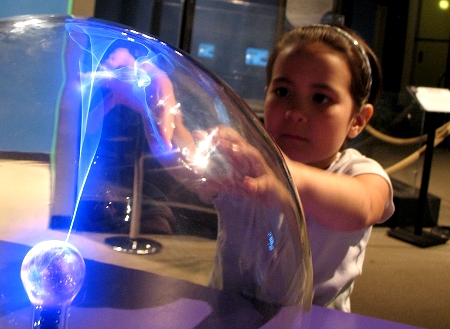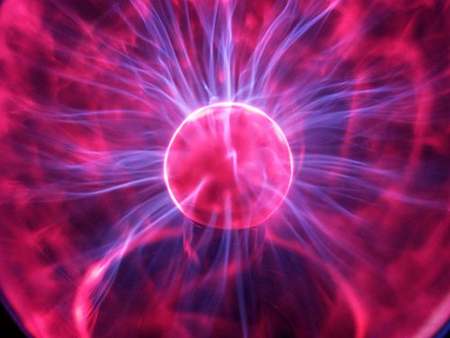Lesson Plan: Plasma Globes and Electricity

(Class Activity courtesy of Penn State University and Helene Tack)
Grade Level: 3-5. Duration: 2 class periods, 45 minutes per class
OVERVIEW
Using a plasma ball or lightning globe, students test various objects to see if they pull the electric current generated by the globe to them. Students then explore how the globe excited electrons inside the fluorescent bulbs to make them light.
Prerequisite Skills
Knowledge of conductors and insulators, electrical circuits, incandescent light bulb structure is helpful.
Assessment
Students are informally assessed through their contributions to science discussions before, during, and after the experiments. Students will be formally assessed through their written conclusion on their science data sheets.
LEARNING OBJECTIVES
After completing the activities, students will be able to list conductors and insulators, and compare and contrast incandescent bulbs with compact fluorescent bulbs.
STANDARDS
Pennsylvania Academic Standards: Science and Technology
- Area 3.2: Inquiry and Design, Grade 4 –
Standard A: Identify and use the nature of scientific and technological knowledge. Distinguish between a scientific fact and a belief. Provide clear explanations that account for observations and results. Relate how new information can change existing perceptions.
Standard C: Recognize and use the elements of scientific inquiry to solve problems. Generate questions about objects, organisms and/or events that can be answered through scientific investigations. Design an investigation. Conduct an experiment. State a conclusion that is consistent with the information.
- Area 3.4: Physical Science, Chemistry and Physics, Grade 4 –
Standard B: Know basic energy types, sources and conversions. Identify energy forms and examples (e. g., sunlight, heat, stored, motion). Know the concept of the flow of energy by measuring flow through an object or system. Describe static electricity in terms of attraction, repulsion and sparks. Apply knowledge of the basic electrical circuits to design and construction simple direct current circuits. Classify materials as conductors and nonconductors. Know and demonstrate the basic properties of heat by producing it in a variety of ways. Know the characteristics of light (e. g., reflection, refraction, absorption) and use them to produce heat, color or a virtual image.
MATERIALS
- Science recording sheet (made/customized by teacher)
- Pencil
- Lightning globe (plasma ball)
- Various insulators and conductors, enough for each student to have one to test. (Possible items: metal spoon, wooden object, plastic, glass, fabric, etc.)
- Tube fluorescent bulb
- Compact fluorescent bulb
- Incandescent bulb
PROCEDURES
Preparation
Before testing the objects, discuss the concept of insulators and conductors. Then give each student a sheet that lists each of the objects to be tested. On these sheets, they will predict whether the object will act as an insulator or conductor when it comes into contact with the plasma ball. Once students record their predictions, the sheets should be filed away for later reference. Students should be able to easily group each item.
Call students by table to a flat, open area of the classroom, where they can easily observe. Turn off the lights and turn on the lightning ball. Ask students what they see, and to try to explain why they can see the electricity in the globe. Is something conducting the electricity? If they can’t see a conductor, does that mean one does not exist? The goal of these questions is to help students reach the conclusion that gases inside the globe conduct the electricity from the metal rod to the outsides of the glass.
DAY 1: Experimenting with the Plasma Globe
- Have students sit in a group or a circle so all can see.
- Ask students to predict what will happen if a conductor is put on the glass.
- Ask one student what will happen when the teacher puts a hand on the globe. Will it act like a conductor or an insulator? Conduct the test, then ask what conclusions can be drawn from their observations about human bodies and electricity.
- Hand each student an object.
- Have students come up to test their item. Put items in two separate piles, the first for objects to which the lightning was attracted, the second, for those that did not attract it.
- Discuss findings. Ask, for example, why the lightning was or was not attracted, and how a lemon is similar or different from human bodies in conducting electricity. After testing, record the results for students to copy later, or have students take out their sheets to compare their predictions with the results.
- Test an incandescent bulb, asking students to predict whether or not it the lightning globe will make it light. Test it. What ideas can students suggest as to why it did not work? Have them relate what they know about incandescent bulbs and what parts must be touching the circuit for one to work.
- Ask the students what kind of light bulbs are used in their classroom. Have they seen a long fluorescent bulbs before? Show them the one in the box. How do these bulbs differ from incandescent bulbs? Will it light?
- Have students take out their science sheets, recording the results of the incandescent bulbs, and making a prediction about the fluorescent bulb. What is inside the fluorescent bulb that might make it light?
- Test the tube fluorescent bulb. Held near the globe, it will light. What is the difference between the two types of bulb? Ask students what they think might be inside the bulb that makes it work. They can consider how the fluorescent bulb relates to the lightning globe.
- Ask students if they think human bodies can conduct electricity. Then, ask if the bulb will light if the teacher and another student hold the light. Why or why not?
- While crouching barefoot on the floor, with a full palm laid upon the globe, hold one end of the tube fluorescent bulb. Have a student hold the other end close to your hand. The tube lights. Sit down, the light goes out. Do this several times, adjusting the conditions slightly for different effect. Ask students to determine the reason for the differences in outcomes — why the bulb sometimes work and sometimes does not. Students may observe, for example, that the teacher was sitting differently in different instances, and that the rubber soles of the teacher’s shoes insulate electricity, keeping it from going into the ground/grounding so that it goes into the bulb, instead.

- Ask students if they have seen another, new kind of light bulb, the compact fluorescent bulb. Ask them how it is similar or different to an incandescent bulb.
- Test the compact fluorescent bulb. Is it more like the tube light or the incandescent light?
- If time allows, try to light the compact fluorescent by touching the globe, the bulb, and another student touching the bulb. Ask why this might work. (5 minutes) If time allows, go around the circle and allow students to touch the end of the tube light to try to make it light.
END DAY 1 / BEGIN DAY 2: Reflecting Upon the Learning Experience
- Have students fill out an evaluation of what they have learned. One example of a helpful evaluative worksheet is the KLEW chart, “Know, Learning, Evidence, and Wonder.” Information on KLEW charts can be found here.
- Have students record their results for the conductors/insulators and complete any additional written sheets.
Troubleshooting
It may be difficult to keep students quiet and controlled enough to move on with the lesson at some points. Try to find additional ways to get more students involved more actively throughout the lesson. One way to do so is by allowing all students to touch the fluorescent bulb to make it light.
Teaches should seek to lead students to the right idea but preserve that inquiry approach. Try to avoid giving away the answers or outcomes, so that the students really pay attention and observe carefully, determining each answer for themselves.
Filed under: Class Activities, Grades K-5, Grades K-5, Lesson Plans
Tags: Class Activities, Curriculum, Grades 3-5, Lesson Plan, Plasma Physics









